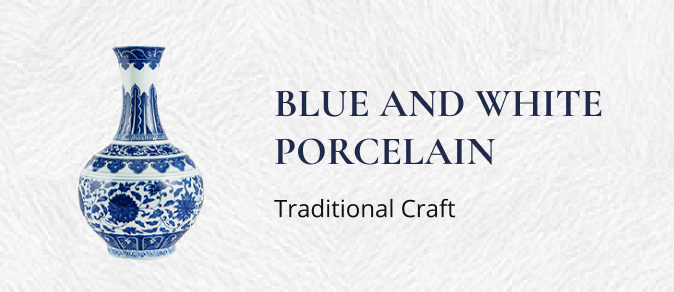Online Exhibition


Blue glazes were first developed by ancient Mesopotamians to imitate lapis lazuli, which was a highly prized stone. Blue and white decoration first became widely used in Chinese porcelain in the 14th century, after the cobalt pigment for the blue began to be imported from Persia. It was widely exported, and inspired imitative wares in Islamic ceramics, and in Japan, and later European tin—glazed earthenware such as Delftware and after the techniques were discovered in the 18th century, European porcelain.
Qing Guangxu
Blue And White Lotus Eight Auspicious Pattern Celestial Bottle
The vase is originated from the Yu Hu spring bottle, skimming, long neck, round belly, and rounded embodiment. This bottle has a classic blue and white bottle shape. The neck is dressed in blue and white banana leaf patterns, and the abdomen is wrapped in a lotus pattern. The combination of green & lotus represent “Integrity”, which the Qing Dynasty court wishes to achieve in governance. In addition, the outer wall of the bottle is decorated with blue and white, and its mouth has wave patterns and Ruyi cloud head patterns. There are back patterns, tangled flowers, and Ruyi patterns on the shoulders to create an excellent balance in majestic.
The bottom of this product is written in the “Daqing Guangxu Year System” six-character, double-line regular script. It is a furnishings of the Qing Dynasty. It is auctioned in the Sotheby June 11th to 22nd, with Reference No. 38. This vase is in pristine condition, slightly worn on the surface.
Ming Wanli
Blue and White Blooming Dragon and Phoenix Pattern Pot with Beam “Da Ming Wanli Year System”
This pot is finely detailed with a short neck, wide shoulders, fuller abdomen, curvature, and applied loop handle. The overall pot is decorated with a dragon and phoenix pattern. The gaps, shoulders, necks, curls, and applied handle are dressed in Ganoderma patterns, offering a sense of serenity. The loop handle is firmly pure white, painted with a lotus petal pattern, create a great contrast with its well-balanced dragon and phoenix pattern.
At the bottom of this product, the six-character double-line regular script of the “Daming Wanli years” is written in blue and white, system that specializes in Yuqianxian during the Wanli period. Currently exclusively present in Sotheby’s “Bogu: Asian Art Treasure” online. It was taken on March 24, 2021, No. 531. The part of the handle is slightly tilted, one end was once broken & restalled, and the other end emerges a fine fissure. In addition, the overall surface of this product has a little kiln burning defect and normal wear, which is the traces of time left by age.
Qing Kangxi
Blue and White Group of Virtuous and Elegant Collection Map
This blue and white dish is magnificent, and has a very popular style. Pan-skimming, arc belly, circle feet, and the bottom of the circular shape turn along the side to the edge. The layers are clear and vivid. The overall dish is painted in blue and white. The strokes are clear, the center of the dish is painted with the “Playing Motors” which can be described as elegant. The three bachelors gathered in the suburbs, playing flutes, piano, and drums in joy. The two boys were serving from the side, accompanied by the blooming flowers, this scene was merrily happy. The side of the dish depicts the lotus pattern, and the wide mouth is opened on all sides. The interval is decorated with brocade patterns, making the composition clear, complicated, and orderly, and the shares are fresh and bright. In addition, two relative fruit flowers were seen at the back of the dish, which showed elegant charm.
This product is currently in Sotheby’s Sotheby’s “Bogu: Asian Art Treasure” online. It was taken on March 24, 2021, number 530. The edge emerge with a fine fissure, about 2 cm long, and it is slightly deformed. The product has slight traces of use and normal kiln burning defects.
Carved Lacquer or Qidiao (Chinese: 漆雕) is a distinctive Chinese form of decorated lacquerware. While lacquer has been used in China for at least 3.000 years, the technique of carving into very thick coatings of it appears to have been developed in the 12th century CE. It is extremely time consuming to produce, and has always been a luxury product.
Qianlong of Qing Dynasty
Red Colored Vase With Lotus Flowers and Figures in Landscape and Begonia
Begonia barrel is a rare lacquerware in the Qing Dynasty. The whole body is in the shape of Begonia petals, it has sloping shoulder, deep belly, cylinder base with a wide bottom. The inside and bottom of the statue are painted with black lacquer, and the outside of the statue is painted with red lacquer. The edge of the mouth and edge of the foot has the same width, and each is carved with a circle pattern, and the neck is carved with banana leaves, and the blank canvas is fill with the tortoise-back brocade ground pattern, the shoulders and ring feet are also carved with a circle of twisted lotus patterns. The belly of the bareel is themed with the painting of “群仙祝壽圖” (Congratulations on the Birthday of the Immortals). Consecrated in the middle, with the intertwined branches of the lotus pattern as intervals, and four sets of congratulate painting are depicted respectively. There are three figures in them, namely a master and two boys, Master wearing a cloth robe in an angelic demeanor, sometimes holding a staff, sometimes holding a peach, sometimes holding Ruyi. The boys are smart & energetic, hugging the birthday treasures such as flower baskets, gourd bottles, books, longevity peaches, etc., the atmosphere is harmonious and happy. In the painting, there are three uniquely delicate layers of brocade as the background , representing water, land, and clouds respectively.
This product was sold at Bonhams on May 27, 2021, no. 79. It is an ornamental vase from the Qing Palace collection. There is a recent example in the National Palace Museum, Taipei, for no. 32. In addition, the Victoria and Albert Museum in the UK also has a Qing Qianlong carved red begonia for reference. The carved pattern is similar to this, and the collection number is 904-1873.
Qianlong of Qing Dynasty
Qianlong Period Box with The Pattern for Bogu Flower
The carrying box is composed of two “convex” shapes to form a “concave” shape, which is unevenly unique. The carrying box uses the art of lacquer carving to depict Bogu flower patterns on the utensils, showing the gorgeous luxury of the “Qianlong” Dynasty. The six sides of the box are engraved with different groups of Bogu flower patterns, including elephant leg vase, chicken leg vase, appreciation vase, and other vases. Four seasons of flowers are placed in the interior, and there are elegant incense, scriptures, auspicious animals, banana fans pattern, and so on. In addition, the Bogu flower pattern uses the tortoise pattern as the brocade and the kidnapper dragon pattern as the frame, where the outside of the frame is embossed with the pattern of tangled branches and frangipani, paving a prosperous scene.
The top of the carrying box is set with a gilt bronze handle with the word “喜” (translated as happiness), and there are drawers on both sides of the handle. When you open the two cabinet doors on the front, you can see that there are four compartments and two drawers inside, decorated with grinding and tortoise pattern. In addition, the drawer handles and the copper parts of the facade are all made of gilt bronze, but the doorposts are decorated with bats and vases as the doors, which means blessing and peace.
This is a private collection in Hong Kong, sold at Sotheby’s Hong Kong, 20/21 May 1987, no. 595, and now sold at Sotheby’s Hong Kong, 26/27 May 2021, no. 317. This case was made by the Qing Palace Construction Office and was used for the storage of study accessories in the palace. One of the Qing Palace Collection, now in the Palace Museum, Beijing, is shown in The Complete Collection of Treasures of the Palace Museum: Lacquerware of the Qing Dynasty, Hong Kong, 2006, pl. 45. Another recent reference, with the same Bogu flowers, should be paired with this, sold at Bonhams Hong Kong, 28 May 2019, lot 136.
Qianlong of Qing Dynasty
Red Lidded Box With a Haitang-Style Lid With a Picture of Fishing in the Autumn Mountains
This box is a red-picking work from the “Qianlong” period. The carvings are neat and delicate, complex and interesting. The box is in the shape of a begonia flower, with a wooden body, black lacquer on the inside, dark and translucent, and red lacquer on the outside, which is auspicious and brilliant. The big red lacquer carving has the meaning of welcoming blessings and happiness, and the picture on the cover box conveys a picture of peace and contentment and living a prosperous life. The lid of the box is both embossed with sea ripples as the bottom and fringe patterns and lotus patterns as the frame. It is lined with a harmonious village. There are ancient trees and lush mountains in the distance. Going across the river, pedestrians pass by on the road, and there are leisurely stops to enjoy the scenery, while the fishermen on the side are throwing fishing nets, it can also be seen that the harvest is huge, and they are overjoyed. A matching engraved letters on the edge of the lid box, the petals of the begonia are exquisite, protruding part has four seasons of flowers, and the concave part has the eight treasures of Taoism. The overall look represents auspicious, dignified, and elegant.
This is a good device for a study desk. This product has been handed down from the Qianlong period to the present. It is now sold at Sotheby’s Hong Kong on May 26/27, 2021, no. 515. The overall condition is still pristine, but there are small peeling and partial finishing on the edge, and carved edges The corners are also slightly knocked and cracked, which is normal.

